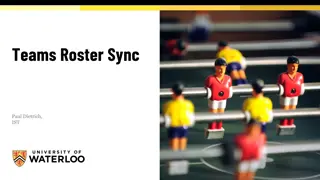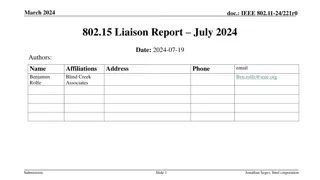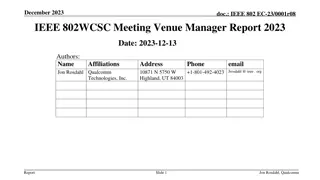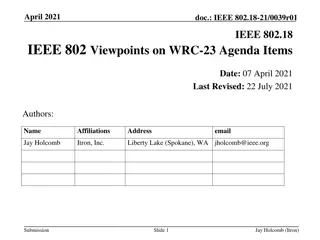Understanding Start Time Sync Procedures in IEEE 802.11-21/1679r0
In the document authored by Ronny Yongho Kim et al., the focus is on start time sync PPDU medium access considering internal collision in IEEE 802.11-21/1679r0. It discusses the importance of defining a clear rule to resolve internal collision cases during medium access procedures. Specific attention is given to handling internal collisions related to backoff counters of different ACs. The document also examines the implications of internal collisions on the transmission process and presents recommendations for addressing such scenarios within the specified protocol.
Download Presentation

Please find below an Image/Link to download the presentation.
The content on the website is provided AS IS for your information and personal use only. It may not be sold, licensed, or shared on other websites without obtaining consent from the author. Download presentation by click this link. If you encounter any issues during the download, it is possible that the publisher has removed the file from their server.
E N D
Presentation Transcript
October 2021 Start time sync PPDUs medium access considering internal collision IEEE 802.11-21/1679r0 Date: 2021-10-11 Authors: Name Ronny Yongho Kim Affiliations Address Korea National University of Transportation Korea National University of Transportation Hyundai Motor Company Phone email ronnykim@ut.ac.kr Juseong Moon theonebird81@gmail.com Hyojin Jung hyojin@hyundai.com Submission Slide 1 Ronny Yongho Kim, KNUT
October 2021 IEEE 802.11-21/1679r0 Introduction In Draft 1.1, Start time sync PPDUs medium access is defined [1] The defined medium access procedure does not cover internal collision cases While waiting with the backoff counter of a certain AC at zero, the backoff counter of other AC may become zero leading to internal collision There should be a clear rule to resolve the internal collision This contribution discusses Start time sync PPDUs medium access in case of the internal collision Submission Slide 2 Ronny Yongho Kim, KNUT
October 2021 IEEE 802.11-21/1679r0 Recap: Start time sync PPDUs medium access In Draft 1.1, Start time sync PPDUs medium access is defined [1] A STA of an MLD operating on a link that is part of an NSTR link pair for that MLD shall follow the channel access procedure described below: 1. The STA may initiate transmission on a link when the medium is idle as indicated by the physical and virtual CS mechanism and one of the following conditions is met: a. The STA obtained an EDCA TXOP following the procedure in 10.23.2.4 (Obtaining an EDCA TXOP). b. The backoff counter of the STA is already zero, and the STA operating on the other link of NSTR link pair of the affiliated MLD obtains an EDCA TXOP following the procedure in 10.23.2.4 (Obtaining an EDCA TXOP). 2. When the backoff counter of the STA reaches zero, it may choose to not transmit and keep its backoff counter at zero. 3. If the backoff counter of the STA has already reached zero, it may perform a new backoff procedure following deferral procedures as described in 10.23.2.4 (Obtaining an EDCA TXOP) and 10.3.4.3 (Backoff procedure for DCF). CW[AC] and QSRC[AC] are left unchanged. Submission Slide 3 Ronny Yongho Kim, KNUT
October 2021 IEEE 802.11-21/1679r0 Internal collision In Draft 1.1, internal collision is defined for a STA that has chosen not to transmit A STA that chooses not to transmit after the backoff counter reached zero on a link of NSTR link pair may have one or more EDCAF backoff counters with value zero on that link. The STA that initiates transmission on that link following condition a) or b), and has one or more EDCAF backoff counters that already reached zero shall choose only one implementation specific EDCAF for the transmission. There is an ambiguity on handling multiple EDCAF backoff counters When more than two EDCAF backoff counters become zero, this shall be handled as an internal collision There are several possible cases for choosing only one implementation specific EDCAF However, due to internal collision resolution, while keeping one EDCAF backoff counter at zero, if one of the other EDCAF backoff counters becomes zero, a STA shall choose one EDCAF backoff counter to keep zero. Submission Slide 4 Ronny Yongho Kim, KNUT
October 2021 IEEE 802.11-21/1679r0 Internal collision Letting multiple EDCAF backoff counters become zero is a violation of internal collision resolution (10.23.2.4) In order for multiple EDCAF backoff counters to become zero, a STA, which applied a rule may choose to not transmit and keep its backoff counter at zero to one of ACs, shall apply the same rule to the other ACs. While keeping one EDCAF backoff counter at zero, if one of the other EDCAF backoff counters becomes zero, a STA shall choose the AC between two ACs which become EDCAF backoff counter zero and may choose to not transmit and keep its backoff counter at zero How to handle CW[AC] and QSRC[AC] for the AC which is not chosen ? In internal collision resolution, when an AC is not chosen, CW[AC] and QSRC[AC] shall be updated However, this is a special case, CW[AC] and QSRC[AC] might be handled differently Which AC to choose might not be an implementation specific As in the base spec, higher priority AC might be chosen In multi-link case, the AC which has reached zero first might be chosen Submission Slide 5 Ronny Yongho Kim, KNUT
October 2021 IEEE 802.11-21/1679r0 Internal Collision Resolution In link 1, AC_VI backoff counter has reached zero and chosen not to transmit While keeping AC_VI backoff counter at zero, AC_VO backoff counter has become zero. A STA shall decide a backoff counter between the two to keep at zero The AC of higher priority AC The AC reached zero first As a result of internal collision resolution, the ACs of frames transmitted over link 1 and link 2 using synchronized transmission might be different. CW[AC] and QSRC[AC] ?? SIFS BA AP MLD1 AP1 AC_VI Backoff AC_VI Backoff Link1 3 2 1 0 4 7 6 5 3 2 1 0 STA MLD1 STA1 AC_VO PPDU AC_VO PPDU 3 2 1 0 4 AC_VO Backoff BA SIFS AC_VI Backoff AP MLD1 AP2 AC_VI Backoff Link2 1110 9 8 7 6 5 4 3 2 1 0 STA MLD1 STA2 AC_VO PPDU AC_VO PPDU 3 2 1 0 6 5 4 AC_VO Backoff Submission Slide 6 Ronny Yongho Kim, KNUT
October 2021 IEEE 802.11-21/1679r0 Internal Collision Resolution As a result of internal collision resolution, the ACs of frames synchronously transmitted over multiple links might be different. A rule for CW[AC] and QSRC[AC] needs to be decided If the AC of higher priority AC is chosen CW[AC] and QSRC[AC] may be updated Penalty for not to transmit and keep its backoff counter at zero CW[AC] and QSRC[AC] shall be unchanged It could have transmitted the frame. It is waiting for the other link s backoff reach zero The AC reached zero first CW[AC] and QSRC[AC] shall be unchanged If the frames of the same AC shall be transmitted over multi-link, a different rule needs to be defined Submission Slide 7 Ronny Yongho Kim, KNUT
October 2021 IEEE 802.11-21/1679r0 Reference [1] Draft P802.11be D1.1 [2] 11-20/1730r3, UL Sync Channel Access Procedure [3] 11-21/0514r10, CC34 Comment Resolution for Sync PPDU start time Submission Slide 8 Ronny Yongho Kim, KNUT
October 2021 IEEE 802.11-21/1679r0 Straw Poll #1 Is a rule for internal collision resolution required in Start time sync PPDUs medium access? Yes No Submission Slide 9 Ronny Yongho Kim, KNUT























